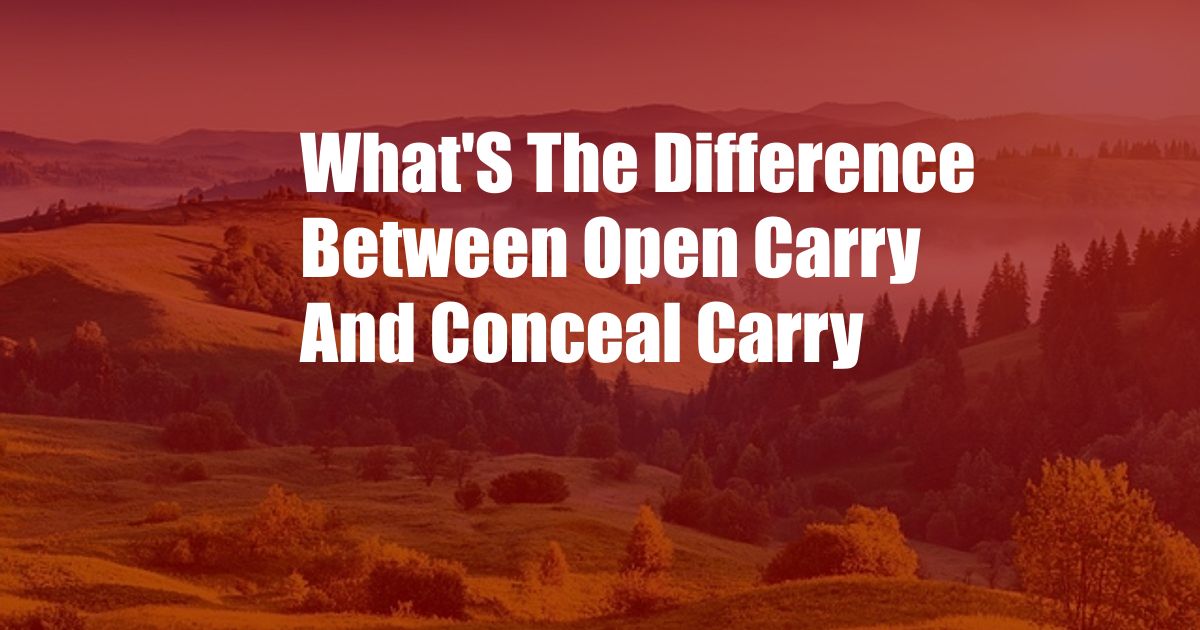
Open Carry vs Conceal Carry: Understanding the Differences
In the world of firearms, there are two main ways to carry a weapon: open carry and conceal carry. Both methods have their own advantages and disadvantages, and it’s important to understand the differences before deciding which one is right for you. In this article, we’ll dive into the intricacies of open carry and conceal carry, exploring their definitions, legal implications, and practical considerations.
Let’s start with a personal anecdote to set the stage. I remember vividly a time when I was walking down a busy street and noticed a man openly carrying a handgun on his hip. It was a bit unsettling, and I couldn’t help but wonder if he had good intentions or if he was a potential threat. This incident sparked my curiosity about the different ways people carry firearms, and I decided to dig deeper into the topic.
Open Carry vs Conceal Carry: Definitions and Legal Implications
Open Carry: This refers to carrying a firearm in a visible manner, typically on the hip or shoulder. It’s often associated with the Second Amendment right to keep and bear arms. However, open carry laws vary from state to state, and some jurisdictions have strict regulations or even prohibit it.
Conceal Carry: In contrast, conceal carry involves carrying a firearm in a hidden manner, such as under a jacket or in a purse. It requires a permit or license in most states, and the application process usually involves a background check and a safety course. Conceal carry is generally considered more discreet and less likely to cause public alarm.
Practical Considerations for Open Carry and Conceal Carry
Beyond the legal implications, there are also practical considerations to take into account when choosing between open carry and conceal carry.
- Safety: Conceal carry is generally considered safer because it reduces the risk of accidental discharge or theft. Open carry, on the other hand, can be more provocative and may increase the likelihood of confrontation.
- Comfort: Conceal carry can be more comfortable, especially for extended periods of time. Open carry, on the other hand, can be more inconvenient and may require a specialized holster.
- Social Stigma: Open carry is often met with negative perceptions and can be perceived as intimidating by some people. Conceal carry, on the other hand, is more discreet and less likely to cause social anxiety.
- Legal Considerations: As mentioned earlier, open carry laws vary from state to state, and it’s crucial to be aware of the specific regulations in your jurisdiction. Conceal carry, while generally more regulated, offers more legal protection in cases of self-defense.
Latest Trends and Developments in Open Carry and Conceal Carry
The world of firearms is constantly evolving, and both open carry and conceal carry are experiencing new developments.
- Increased Conceal Carry Permits: The number of people obtaining conceal carry permits has been steadily rising in recent years. This is likely due to increased awareness of self-defense and a desire for personal safety.
- Technological Advancements: Conceal carry technology is不断进步,实现更舒适、更隐蔽的携带方式。例如,腰带内枪套和袖套枪套正在变得越来越流行。
- Legal Challenges: Open carry laws are still subject to legal challenges in some states. Activists are pushing for greater access to open carry, while opponents argue for stricter regulations.
- Social Media and Public Perception: Social media platforms and online forums are playing a significant role in shaping public perceptions of open carry and conceal carry. Advocates and opponents alike are using these platforms to share their perspectives and engage in debates.
Tips and Expert Advice for Responsible Carry
Whether you choose open carry or conceal carry, it’s essential to do so responsibly. Here are some tips and expert advice to keep in mind:
- Training: Proper training is paramount for both open carry and conceal carry. It’s essential to learn safe handling, marksmanship, and situational awareness.
- Legal Knowledge: Be well-versed in the firearms laws in your jurisdiction. This includes understanding the requirements for open carry, conceal carry, and self-defense.
- Responsible Behavior: Always carry your firearm responsibly. Avoid unnecessary display of weapons, and never point a firearm at anyone unless it’s in self-defense.
- Situational Awareness: Pay attention to your surroundings and be aware of potential threats. Avoid confrontations and de-escalate situations whenever possible.
FAQs on Open Carry and Conceal Carry
- Q: What are the main differences between open carry and conceal carry?
A: Open carry involves carrying a firearm visibly, while conceal carry involves carrying it hidden. - Q: What are the legal requirements for open carry and conceal carry?
A: Laws vary from state to state, but open carry usually requires no permit, while conceal carry typically requires a permit or license. - Q: Which type of carry is safer?
A: Conceal carry is generally considered safer due to the reduced risk of accidental discharge or theft. - Q: What are the advantages and disadvantages of open carry?
A: Advantages include exercising the right to bear arms and deterrence of crime. Disadvantages include increased risk of confrontation and negative public perception.
Conclusion
Open carry and conceal carry are two distinct ways of carrying a firearm, each with its own advantages and disadvantages. The right choice for you depends on your individual circumstances, legal jurisdiction, and personal preferences. Safety, comfort, legal considerations, social stigma, and training are important factors to take into account. Remember, responsible firearm ownership is paramount, and always prioritize safety and legal compliance.
If you have any further questions or would like to learn more about open carry and conceal carry, feel free to leave a comment below. We’re always here to provide information and support on this important topic.